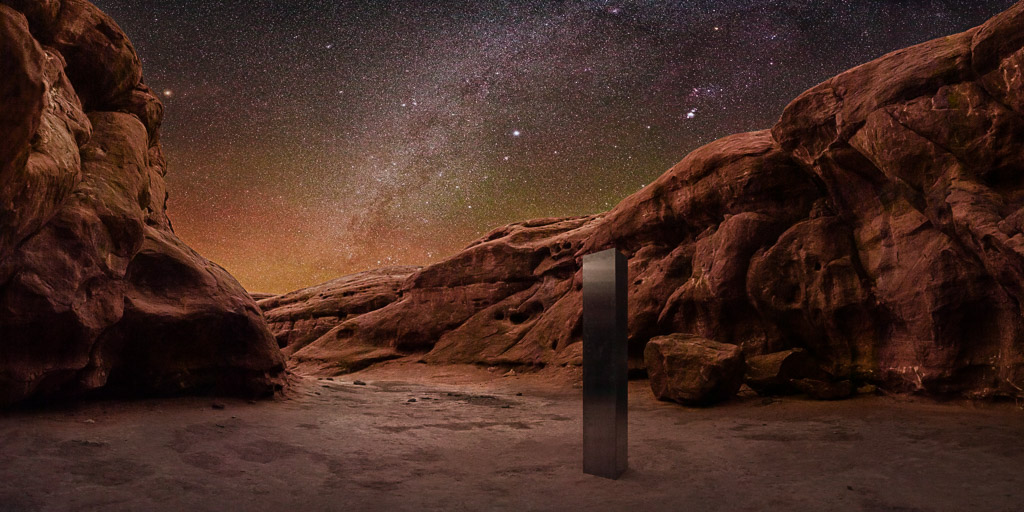Some things in the world just deserve a drop-everything, no-holds-barred trip, and the opportunity to see the Utah Monolith at night was certainly no exception. Even on Thanksgiving. I made the whirlwind trip from Colorado in 25 hours, door-to-door. Having been a longtime fan of Stanley Kubrick’s film 2001, the wonder of the object drew me in, my 8+ hour drive filled with the anticipation of seeing it.
As you probably know, the mysterious metal Monolith (term used loosely, though the internet has dubbed it as such) was discovered by a helicopter crew last week while counting sheep in southeast Utah. No has yet talked of the source/artist/counstructor, but I’m here to tell you that the object is truly a piece of art, the uniqueness of which can’t likely be described in words. It is a robust structure which is embedded into the earth, the marks from the saw blade still evident on the bedrock. How deep it is embedded only a few souls know, but it was constructed to stand the test of time, to survive the elements in the intermittently harsh environment in which it is located. I’m enthralled by the fact that someone would do this, and that word wouldn’t get out until randomly discovered from the air (I’m gonna call Westworld production workers, using their free time to create an homage to Kubrick).
The Utah Monolith at Night
I spent nearly the entire night photographing it as the light from the moon moved across the floor of the mini-amphitheater, until the monolith was finally no longer illuminated by the moon. In full moonlight, the object seems an incongruent oddity of shape and form, stark, blaring loudly the reflection and shadow from the harsh light of the nearly-full moon.
Once fully shaded from the descending moon by the canyon walls, the object began to come to life.
Its stainless steel sides became subtle reflectors of the terrain and light around it, and I swear it seemed to almost glow. As the moonlight moved up the amphitheater walls, the reflections morphed into ephemeral, abstracted renditions of its environment, almost like looking at the reflection of a pond on a windy day, albeit in very slow motion. Once the moon set shortly after 0300, the metamorphosis of the object was complete, the lighting of which would not change until the sun was close enough to the horizon to start turning the light of the sky blue.
Whomever created The Monolith is pure genius, whether they knew it at the time or not. It is a nocturnal wonder, and at night its three sides are radiant, luminously and exquisitely reflecting the changing environment around it.
Art or Offal: What will happen to the Monolith?
I sincerely hope that the Bureau of Land Management does not arbitrarily decide to demolish this piece of environmental art, regardless of the likely scenario that it was installed unlawfully. As far as I’m concerned it is little different than people parading to a panel of pictographs created long ago, and once the excitement dies down, few will journey to see it due to the nature of the road not being amenable to passenger cars. Will someone get lost looking for it at some point? Perhaps. Will some hearty soul get hurt trying to free-solo to the top of it? Nothing would surprise me, as humans seem infinitely capable of not anticipating the consequences of their actions, however seemingly mundane a given action might be.
I’m glad I got to spend a night with the object, and I hope it is still there in 10 years.
I will return, if so (and will bring Windex, a Swiffer dust sweeper, and a torpedo level).
Image information:
I’m not including technical information for Utah Monolith at Night (as it would seem unworthy of the object), except that its 36 component images took 30 minutes to capture, and five hours to composite into this panorama (which can be printed natively–i.e. no interpolation–at 77×38”. My intent was to capture the object in the most base essence of its environment, and I feel that nighttime best represented the primordial qualities of it. View is to SSW, and Orion can be seen above-right of the object, just above the rim; Sirius is the bright star in the center, just below the arc of the ‘northern’ Milky Way, the outer plane of our galaxy.
Print is available for purchase, please contact me directly.

